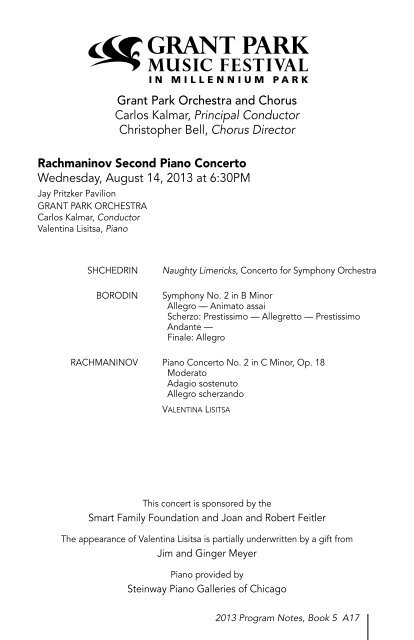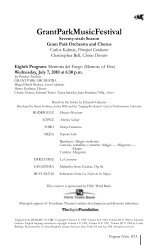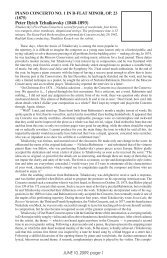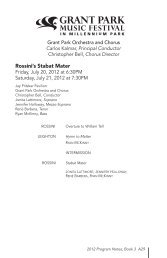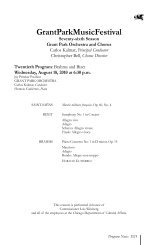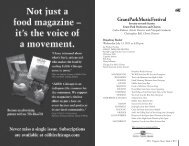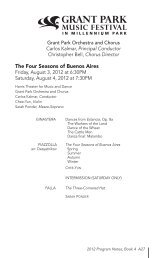Program Notes PDF - The Grant Park Music Festival
Program Notes PDF - The Grant Park Music Festival
Program Notes PDF - The Grant Park Music Festival
Create successful ePaper yourself
Turn your PDF publications into a flip-book with our unique Google optimized e-Paper software.
<strong>Grant</strong> <strong>Park</strong> Orchestra and Chorus<br />
Carlos Kalmar, Principal Conductor<br />
Christopher Bell, Chorus Director<br />
Rachmaninov Second Piano Concerto<br />
Wednesday, August 14, 2013 at 6:30PM<br />
Jay Pritzker Pavilion<br />
<strong>Grant</strong> <strong>Park</strong> orchestra<br />
Carlos Kalmar, Conductor<br />
Valentina Lisitsa, Piano<br />
SHCHEDRIN<br />
BORODIN<br />
Naughty Limericks, Concerto for Symphony Orchestra<br />
Symphony No. 2 in B Minor<br />
Allegro — Animato assai<br />
Scherzo: Prestissimo — Allegretto — Prestissimo<br />
Andante —<br />
Finale: Allegro<br />
RACHMANINOV Piano Concerto No. 2 in C Minor, Op. 18<br />
Moderato<br />
Adagio sostenuto<br />
Allegro scherzando<br />
Valentina Lisitsa<br />
This concert is sponsored by the<br />
Smart Family Foundation and Joan and Robert Feitler<br />
<strong>The</strong> appearance of Valentina Lisitsa is partially underwritten by a gift from<br />
Jim and Ginger Meyer<br />
Piano provided by<br />
Steinway Piano Galleries of Chicago<br />
2013 <strong>Program</strong> <strong>Notes</strong>, Book 5 A17
carlos kalmar’s biography can be found on page 8.<br />
Wednesday, August 14, 2013<br />
Pianist Valentina Lisitsa is at ease in a vast repertoire<br />
ranging from Bach and Mozart to Shostakovich and Bernstein.<br />
Her orchestral repertoire alone includes more than forty<br />
concertos. In May 2010, she performed the Dutch premiere<br />
of Rachmaninov’s “New 5th” Concerto in her debut with the<br />
Rotterdam Philharmonic. In June 2012, she made her recital<br />
debut at the Royal Albert Hall in London. <strong>The</strong> performance was<br />
streamed live on her YouTube channel and a recording of the<br />
concert was released on iTunes as well as on DVD by Decca<br />
Classics. Highlights of previous seasons include appearances with the Chicago<br />
Symphony, Seattle Symphony, WDR Cologne, Seoul Philharmonic, San Francisco<br />
Symphony and Pittsburgh Symphony. Her 2011-2012 season featured performances<br />
with the Helsinki Philharmonic and Colorado Symphony and recitals at Ravinia, <strong>Festival</strong><br />
of the Arts Boca, Teatro de Colon in Buenos Aires and Casals <strong>Festival</strong> in Puerto Rico.<br />
Ms. Lisitsa has recorded three independently released DVDs, including her best-selling<br />
set of Chopin’s 24 Etudes, which long held the coveted No. 1 spot on the Amazon<br />
music video list. With more than 30 million YouTube channel views, Valentina Lisitsa is<br />
one of the most sought-after classical musicians on the Web. Last summer, thousands<br />
of music fans worldwide witnessed the live broadcast of Ms. Lisitsa’s practice sessions,<br />
allowing her to show a different aspect of her artistic persona. For two weeks, viewers<br />
watched her prepare almost four hours of new music in daily fourteen-hour-long<br />
sessions.<br />
Joan and Robert Feitler<br />
Smart Family Foundation<br />
Joan and Robert Feitler and the<br />
Smart Family Foundation are<br />
proud to sponsor this concert<br />
series at the <strong>Grant</strong> <strong>Park</strong> <strong>Music</strong><br />
Fetsival. Native Chicagoans, the<br />
Feitlers have long celebrated and<br />
supported the arts in this city.<br />
Returning to Chicago in 1996 after<br />
living for many years in Milwaukee,<br />
Joan and Bob Feitler have been<br />
deeply involved in educational and<br />
arts funding through the Smart<br />
Family Foundation and through<br />
their own work with many Chicago<br />
and national organizations.<br />
A18 2013 <strong>Program</strong> <strong>Notes</strong>, Book 5
Wednesday, August 14, 2013<br />
Naughty Limericks,<br />
Concerto for Symphony Orchestra (1963)<br />
Rodion Shchedrin (born in 1932)<br />
Naughty Limericks is scored for piccolo, two flutes, two oboes,<br />
English horn, two clarinets, bass clarinet, two bassoons,<br />
contrabassoon, four horns, four trumpets, four trombones,<br />
timpani, percussion, harp, piano and strings. <strong>The</strong> performance<br />
time is eight minutes. This is the first performance of this work<br />
by the <strong>Grant</strong> <strong>Park</strong> Orchestra.<br />
Rodion Shchedrin, one of the handful of Russian composers of the generation after<br />
Shostakovich whose music has made an impact in the West, was born in Moscow on<br />
December 16, 1932. His father, a well-known musical theorist and writer on music,<br />
encouraged Rodion’s musical interests with piano lessons, but the boy’s formal training<br />
was interrupted by the German invasion in 1941. Shchedrin resumed his musical<br />
education in 1948 at the Choir School in Moscow, where he began to compose, and<br />
he entered the Moscow Conservatory three years later to study piano with Yacob Flier<br />
and composition with Yuri Shaporin. By the time he graduated in 1955, Shchedrin had<br />
established a distinctive idiom that incorporates the styles of both folk music from<br />
various Russian regions and the simple urban street song known as the chastushka.<br />
<strong>The</strong> Russian chastushka is a short, simple song for one, two or more singers with<br />
rhymed texts on an apparently limitless number of topics. Shchedrin explained, “In<br />
a chastushka there is always humor, irony and a sharp satire of the status quo, its<br />
defenders and the ‘leaders of the people.’ Even such powerful or dreaded names as<br />
Marx, Lenin and Stalin have been ridiculed in chastushki. Everything that occurs in the<br />
life of the people, from events of historic importance to the most intimate sensations,<br />
finds its way into chastushki at once, on the same day or — through extemporizing<br />
— at the very moment. [‘Chastushka’ is derived from the adjective chastïy: ‘quick.’]<br />
Brevity is the chief characteristic of the chastushka. Its specifically musical traits are a<br />
four-square and symmetric structure, a deliberately primitive melody of limited scope,<br />
driving syncopated rhythm, improvisation, numerous repetitions involving variation<br />
(chiefly shifting the strong and weak beats), and — which is a must — a sense of humor<br />
pervading both the words and music.”<br />
Shchedrin used chastushki in his Piano Concerto No. 1 (1954), the ballet <strong>The</strong> Hump-<br />
Backed Horse (1956), the First Symphony (1958) and the opera Not Love Alone (1961),<br />
and made them the basis of the flamboyantly virtuosic “concerto for orchestra” that<br />
he composed in 1963, whose title — Ozorniye Chastushki — has been rendered in<br />
English as both Mischievous Folk Ditties and, more frequently, Naughty Limericks.<br />
“Unfortunately, the word chastushka is associated in the minds of many musicians<br />
with simple tunes of eight bars, suggesting nothing but boredom,” Shchedrin wrote.<br />
“I think, however, that this modest and unassuming form may be likened to a door<br />
opening, as in an old fairy-tale, upon a world of most varied and inexhaustible musical<br />
riches. In Naughty Limericks, conceived as a virtuosic orchestral work, I treat only the<br />
comic and dance chastushka tunes. <strong>The</strong> concertante style and virtuosic effects are, to<br />
my mind, inherent in this type of chastushka.”<br />
2013 <strong>Program</strong> <strong>Notes</strong>, Book 5 A19
Symphony No. 2 in B minor (1869-1877)<br />
Alexander Borodin (1833-1887)<br />
Borodin’s Symphony No. 2 is scored for two piccolos, two flutes,<br />
oboe, English Horn, two clarinets, two bassoons, four horns, two<br />
trumpets, three trombones, tuba, timpani, percussion, harp and<br />
strings. <strong>The</strong> duration is 26 minutes. <strong>The</strong> <strong>Grant</strong> <strong>Park</strong> Orchestra first<br />
performed this Symphony on August 19, 1936, with Clarence<br />
Evans conducting.<br />
When the Soviet government finally got around to erecting a monument to Alexander<br />
Borodin, it was not to honor his contributions to music but rather those that he made to<br />
science and medicine. During his lifetime, Borodin was known less as a musician than as<br />
an eminent chemist who invented the nitrometer and as the distinguished physician who<br />
helped to found the School of Medicine for Women in St. Petersburg. His busy schedule<br />
left him little time for writing music, and he dubbed himself a “Sunday composer.” Other<br />
than vacations and an occasional weekend, Borodin could only compose when he was<br />
too ill to leave home. Given the often frail state of his constitution, those days were quite<br />
frequent and not unwelcome, and his musical friends actually wished him sickness rather<br />
than health so that could devote himself to his creative work. <strong>The</strong> Second Symphony<br />
was completed while Borodin was confined to bed with an inflamed leg.<br />
Borodin had taken up the cudgel of forging a national musical identity for his native<br />
land in 1862, when he became associated with his friend Modeste Mussorgsky and<br />
three others in the group of Russian composers known as “<strong>The</strong> Five.” In 1869, Borodin<br />
told Vladimir Stasov, a musicologist and the chief journalistic champion of <strong>The</strong> Five,<br />
that he was interested in composing an opera on a Russian historical topic, and the<br />
writer drew up a scenario based on the ancient tales about Prince Igor. Some of the<br />
early sketches for Prince Igor, to which Borodin returned throughout his life but never<br />
completed, were borrowed for the Second Symphony. Indeed, so much of the mood<br />
and matter of the opera found their way into the Symphony that Stasov wrote, “Borodin<br />
was haunted when he wrote this Symphony by the picture of feudal Russia, and he<br />
tried to paint it in his music.” Stasov reported that Borodin had specific images in mind<br />
when composing this work: the first movement was purportedly inspired by a vision of<br />
a gathering of 11th-century warriors; the third by a legendary Slavic minstrel; the finale,<br />
featuring approximations of the sounds of ancient instruments, by a hero’s banquet.<br />
<strong>The</strong> first movement of the Symphony creates a characteristically Russian quality<br />
through several techniques: its melodic and harmonic modalism, which evokes a certain<br />
oriental or even primitive mood; the vivid brilliance of its scoring, often dominated by the<br />
brasses (Borodin and Rimsky-Korsakov had undertaken extensive studies of the military<br />
band, and believed that the brass instruments were capable of more virtuosity than had<br />
hitherto been required of them); and the elemental rhythmic energy that accumulates<br />
around the many repetitions of its craggy opening motive. <strong>The</strong>re are several lyrical<br />
episodes in this sonata-form movement, but the music’s dominant impression is one<br />
of ferocious and enduring strength. <strong>The</strong> second movement is a winged Scherzo that,<br />
according to Gerald Abraham, “suggests the gleam of sunlight upon the helmets of<br />
Slavic warriors.” <strong>The</strong> limpid central trio employs an arched melody that resembles an<br />
Italian barcarolle in its warm lyricism. <strong>The</strong> slow third movement recalls an ancient bardic<br />
strain, perhaps an epic about fearsome struggles against sinister enemies. <strong>The</strong> finale<br />
is a festival of blazing orchestral color that combines vigorous dance themes, striding<br />
melodies and forceful dramatic gestures.<br />
A20 2013 <strong>Program</strong> <strong>Notes</strong>, Book 5<br />
Wednesday, August 14, 2013
Wednesday, August 14, 2013<br />
Piano Concerto No. 2 in C minor, Op. 18<br />
(1900-1901)<br />
Sergei Rachmaninov (1873-1943)<br />
Rachmaninoff’s Piano Concerto No. 2 is scored for pairs of<br />
woodwinds, four horns, two trumpets, three trombones, tuba,<br />
timpani, percussion and strings. <strong>The</strong> performance time is 33<br />
minutes. <strong>The</strong> <strong>Grant</strong> <strong>Park</strong> Orchestra first performed this Concerto<br />
on August 24, 1938, with Walter Steindel conducting. <strong>The</strong> soloist<br />
was Alec Templeton.<br />
When he was old and as mellow as he would ever get, Rachmaninov wrote these<br />
words about his early years: “Although I had to fight for recognition, as most younger<br />
men must, although I have experienced all the troubles and sorrow which precede<br />
success, and although I know how important it is for an artist to be spared such troubles, I<br />
realize, when I look back on my early life, that it was enjoyable, in spite of all its vexations<br />
and bitterness.” <strong>The</strong> greatest “bitterness” of Rachmaninov’s career was the total failure<br />
of the Symphony No. 1 at its premiere in 1897, a traumatic disappointment that thrust<br />
him into such a mental depression that he suffered a complete nervous collapse.<br />
An aunt of Rachmaninov, Varvara Satina, had recently been successfully treated for<br />
an emotional disturbance by a certain Dr. Nicholas Dahl, a Moscow physician who was<br />
familiar with the latest psychiatric discoveries in France and Vienna, and it was arranged<br />
that Rachmaninov should visit him. Years later, in his memoirs, the composer recalled<br />
the malady and the treatment: “[Following the performance of the First Symphony,]<br />
something within me snapped. A paralyzing apathy possessed me. I did nothing at all<br />
and found no pleasure in anything. Half my days were spent on a couch sighing over<br />
my ruined life. My only occupation consisted in giving a few piano lessons to keep<br />
myself alive.” For more than a year, Rachmaninov’s condition persisted. He began his<br />
daily visits to Dr. Dahl in January 1900. “Dahl had inquired what kind of composition<br />
was desired of me, and he was informed ‘a concerto for pianoforte.’ In consequence, I<br />
heard repeated, day after day, the same hypnotic formula, as I lay half somnolent in an<br />
armchair in Dr. Dahl’s consulting room: ‘You will start to compose a concerto — You will<br />
work with the greatest of ease — <strong>The</strong> composition will be of excellent quality.’ Always<br />
it was the same, without interruption.... Although it may seem impossible to believe,”<br />
Rachmaninov continued, “this treatment really helped me. I started to compose again at<br />
the beginning of the summer.” In gratitude, he dedicated the new Concerto to Dr. Dahl.<br />
<strong>The</strong> Concerto begins with eight bell-tone chords from the piano that herald the<br />
surging main theme, announced by the strings. A climax is achieved before a sudden<br />
drop in intensity makes way for the arching second theme, initiated by the soloist. <strong>The</strong><br />
development, concerned largely with the first theme, is propelled by a martial rhythm<br />
that continues with undiminished energy into the recapitulation. <strong>The</strong> second theme<br />
returns in the horn before the martial mood is re-established to close the movement. <strong>The</strong><br />
Adagio is a long-limbed nocturne with a running commentary of sweeping figurations<br />
from the piano. <strong>The</strong> finale resumes the marching rhythmic motion of the first movement<br />
with its introduction and bold main theme. Standing in bold relief to this vigorous music<br />
is the lyrical second theme, one of the best-loved melodies in the entire orchestral<br />
literature, a grand inspiration in the ripest Romantic tradition. <strong>The</strong>se two themes, the<br />
martial and the romantic, alternate for the remainder of the movement. <strong>The</strong> coda rises<br />
through a line of mounting tension to bring the work to a close.<br />
©2013 Dr. Richard E. Rodda<br />
2013 <strong>Program</strong> <strong>Notes</strong>, Book 5 A21


